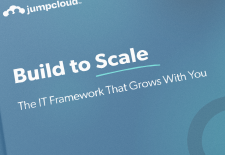Growth is great for any business—new hires join, new markets emerge, and momentum builds. But as growth accelerates, IT teams often find their manual processes can’t keep up.
What worked for a small team, quickly becomes unsustainable as the number of users, devices, and applications grows.
The result?
IT teams become overwhelmed with repetitive tasks, creating bottlenecks that slow the entire organization.
This article provides a roadmap to move beyond reactive, manual processes. We’ll explore the three stages of IT-automation maturity and will show you how to build a scalable system that supports growth, and doesn’t hinder it.
Level 1: Foundational Automation – The Quick Wins
As companies scale, manual processes often become the default way to keep things running. Tasks like creating new user accounts or configuring devices are handled one by one, often over email or chat.
This approach doesn’t hold up when you grow from 20 employees to 200.
Foundational automation is the entry point for getting ahead. It focuses on targeting the high-frequency, low-complexity tasks that consume your team’s day.
By automating routine work, you reduce human error, ensure consistency, and free up your team for more strategic projects.
A 2025 forecast expects 69% of daily managerial work to be fully automated, showing a clear trend toward offloading these repetitive tasks.
Here are some clear signs it’s time for foundational automation:
- User-lifecycle management: Automate the entire user journey by syncing your identity provider with your Human Resources Information System (HRIS). This ensures new hires get the access they need on day one, and permissions are instantly revoked upon departure.
- Device setup: Implement zero-touch deployment to configure new devices with the correct settings, software, and security policies without IT ever touching the hardware.
- Policy enforcement: Automatically apply security policies for disk encryption, password complexity, and screen lock timers across all devices in your fleet to ensure compliance.
Level 2: Connected Processes – Unifying the Sprawling Stack
Once you automate individual tasks, the next stage of IT maturity is to connect these processes across different systems. Many organizations struggle with “tech sprawl,” where a patchwork of disconnected tools creates information silos and operational friction.
This forces IT teams to spend their time manually reconciling information between systems.
The average organization uses 9.3 tools for core IT functions, yet only 19% report having achieved full IT unification. This level of maturity bridges those gaps by creating a unified IT environment where systems communicate seamlessly—creating a single source of truth for users, devices, and access.
Key initiatives at this stage include:
- Integrating IAM with HRIS: A direct link between your Human Resources system and your Identity and Access Management (IAM) platform automates user provisioning. A status change—like a promotion or department transfer—can automatically trigger the correct access permission updates across all connected applications.
- Reversing tech sprawl: By consolidating overlapping tools into a unified platform, you reduce complexity, lower costs, and improve your security posture by centralizing management and visibility.
Level 3: Intelligent Orchestration – Proactive and Strategic IT
The highest level of automation maturity is intelligent orchestration.
At this stage, fully coordinated and data-driven workflows are triggered by business events, enabling your IT environment to respond dynamically and proactively.
This is what moves IT from a reactive support function to a strategic partner that anticipates needs and mitigates risks before they impact the business.
Over 70% of organizations are using data and machine learning (ML) pipelines to train generative AI models as of 2025, which powers this level of sophisticated automation.
Key capabilities in an orchestrated environment include:
- Automated incident response: Security events, such as a suspicious login attempt, automatically trigger containment workflows like isolating a device from the network or locking a user account in seconds.
- Adaptive access control: A Zero Trust philosophy is used to make access decisions dynamically. A user’s access rights can change in real-time based on their location, device security posture, or behavior.
- Predictive analytics: AI and machine learning are used for predictive hardware maintenance or to identify patterns that might indicate an emerging security threat, allowing you to address issues before they cause downtime.
The Path to Sustainable Growth
Growth should energize your organization, not overwhelm it.
The journey from foundational tasks to a fully orchestrated environment provides a clear path to building an IT program that scales with your business. Building a scalable IT foundation is not about reacting to problems—it’s about methodical planning and building systems that are ready for future expansion.
Ready to put these principles into action?
Explore how JumpCloud can help you automate workflows, connect your IT stack, and build a foundation that supports growth at every stage.
Download Build to Scale now to discover a unified platform designed for scalable, modern IT. Spend less time on manual tasks and more time driving your business forward.




